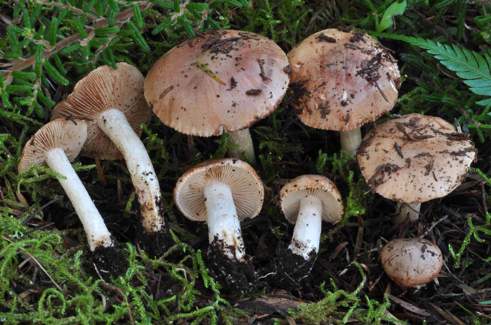 Hebeloma serratum (Photo: N. Siegel)
Hebeloma serratum (Photo: N. Siegel)Taxonomy
Full name: Hebeloma serratum (Cleland) E. Horak, Beihefte zur Nova Hedwigia 65: 318 (1980)Genus: Hebeloma
Section: 'Mediorufa'
Basionym:
Entoloma serratum Cleland [as serrata"], Transactions and proceedings of the Royal Society of South Australia 57: 189 (1933)
Types: AUSTRALIA: South Australia: Mount Compass (approx. 35.3595°S, 138.6198°E, alt. approx. 240 m a.s.l.) on boggy soil in bog, 21 Apr. 1930, J.B. Cleland (Holotype. herbarium acc. no. AD-C10866, HJB1000118).
Heterotypic synonyms:
- Hebeloma lacteocoffeatum B.J. Rees, Mycologia 105 (4): 1050 (2013)
- arrow_drop_downarrow_drop_upEtymology
- arrow_drop_downarrow_drop_upOriginal diagnosisPileus 2-5 cm, perconvexus, irregularis, glaber, albus, in centrum subluteus. Lamellae adnexae, paene disjunctae, confertae, angustae, marginibus serratis, subfusco-carneae. Stipes 3.1 cm. x 6 mm., aequalis, substriatus, solidus, subluteo-albidus. Sporae obliquae, 10-11 x 5 μ. In terra paludosa. S.A. - Mount Compass.
- arrow_drop_downarrow_drop_upEnglish translationPileus distinctly convex, irregular, glabrous, white, pale yellow in the centre. Lamellae adnexed, hardly separated, crowded, narrow, with serrate edges, brownish-pink. Stipe 3.1 cm x 6 mm, equal slightly striate, solid, yellowish-whitish. Spores slightly inequilateral (oblique), 10-11 x 5 μ. On boggy ground. S.A. – Mount Compass.
References
Description
- arrow_drop_downarrow_drop_upThresholds
Description of Hebeloma serratum based on 12 collections
- arrow_drop_downarrow_drop_upMacroscopic descriptionPileus: (19) 25–49 (50) mm diameter; shape convex; characters often hygrophanous; margin characters occasionally smooth, crenulate, involute, reflexed, sulcate or wavy; viscosity tacky when moist; colour variation often unicolour, occasionally two color; colour at centre often fawn, occasionally clay-buff.
Lamellae: attachment often emarginate, occasionally adnexed or decurrent tooth; maximum depth 5–7 mm; number of complete lamellae 60–72; presence of tears often absent or visible with naked eye; white fimbriate edge often present, occasionally very strong, rarely weak.
Cortina presence: no.
Stipe: (22) 31–52 (54) x (5) 6–14 (15) {median} x 6–19 (20) {basal} mm; stipe Q 2.2–7.6; base shape often clavate, occasionally cylindrical or bulbous; floccosity occasionally floccose, floccose at apex, weakly floccose, pruinose at apex or fibrillose; rooting no; thick rhizoids at base absent;
Context: Texture firm; stipe interior often hollow, occasionally stuffed or superior wick; stipe flesh discolouring no; slenderness measure 1.8–12.4; smell occasionally odourless, fruit or raphanoid; taste often weakly bitter, occasionally none where recorded.
Spore deposit colour: Not recorded.
Exsiccata characters: Not recorded.
- arrow_drop_downarrow_drop_upMicroscopic descriptionSpores: shape amygdaloid, occasionally limoniform; colour in microscope often yellow brown, occasionally brown; guttules often yes, occasionally no. papilla often yes, occasionally weak; Spore Code: O2 O3; P0 P1; (D2) D3.
Basidia: (18) 19–34 (36) x 5–8 μm; ave. Q 3.4–4.2; spore arrangement 4 spored;
Cheilocystidia: main shape clavate-stipitate, often gently clavate, rarely capitate-stipitate, clavate-lageniform or clavate-ventricose or spathulate-stipitate; special features observed often septa, rarely clamped septa, irregular, many collapsed in exsiccata, mucronate or sinuate; cheilocystidia ratios: A/M = 1.36–2.23; A/B = 1.52–2.40; B/M = 0.82–1.06.
Pleurocystidia: none seen.
Ixocutis: epicutis thickness (measured from exsiccata) up to 200 μm; ixocutis hyphae width up to 7 μm; ixocutis hyphae encrustation yes; shape of trama elements beneath subcutis often cylindrical or thickly sausage-shaped up to 17 μm wide.
Caulocystidia: Similar to cheilocystidia but larger, up to 140 μm.
- arrow_drop_downarrow_drop_upSpore measurements
- arrow_drop_downarrow_drop_upCheilocystidia measurements
- arrow_drop_downarrow_drop_upHabitat and distributionHebeloma serratum's preferred habitat appears to be woodland pathside, woodland or bog with soil or boggy soil. Where only one possible associate was recorded, the most commonly recorded associate was Leptospermum (60.0%) but Eucalyptus (40.0%) were also recorded. In these cases the most commonly recorded family was Myrtaceae (100.0%). We have additional records where Pomaderris was recorded as a possible associate, but for these collections a number of possible associates were mentioned. Overall the most commonly recorded families are Myrtaceae (100.0%) and Rhamnaceae (14.3%) The growth habit of our collections was gregarious.
According to our current collections, the species is found only in Australasia. On the continent, collections has been found in the WWF biomes The World Wildlife Fund (WWF) have divided the world into 867 terrestrial ecoregions. The ecoregion here is estimated by mapping from the GPS coordinates of the collection using data made available by Dinerstein et al (2017). Use this webtool to explore the ecoregions visually or see a full list of current ecoregions on Wikipedia. temperate broadleaf & mixed forests (75.0%) and mediterranean forests, woodlands & scrub (16.7%), specifically including the ecoregions: Tasmanian temperate rain forests (41.7%), Northland temperate kauri forests (16.7%) and Murray-Darling woodlands and mallee (16.7%). From collector information, it appears collections have been found in the 1.4 Forest – Temperate (66.7%) and 5.4 Wetlands (inland) – Bogs, marshes, swamps, fens, peatlands (33.3%) IUCN habitats We map from the collector's description of the habitat to the International Union for Conservation of Nature (IUCN)'s definition using a standardised set of rules. Please see this page for a full list of IUCN habitats.. Within Australasia we have records from Australia (Tasmania and South Australia) and New Zealand (New Zealand).
- arrow_drop_downarrow_drop_upCommentaryOriginally described by Cleland as an Entoloma, one might expect that this species is from H. sect. Porphyrospora, however the cheilocystidia are typical of H. sect. Mediorufus. Unfortunately we were unable to generate any DNA sequence, but we are confident that H. serratum is conspecific with H. lacteocoffeatum, where the former has nomenclatural priority.
Geographic distribution
Phenology
- arrow_drop_downarrow_drop_upAdditional cited collections